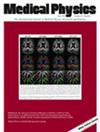Detection and quantification of small and low-uptake lesions for differentiated thyroid carcinoma using non-time-of-flight iodine-124 PET/MRI
Abstract
Background
124-iodine (124I) is used for positron emission tomography (PET) diagnostics and therapy planning in patients with differentiated thyroid cancer (DTC). Small lesion sizes (<10 mm) and low 124I uptake are challenging conditions for the detection of DTC lymph node lesions.
Purpose
The aim of this study was to systematically investigate the lesion detectability and quantification performance under clinically challenging imaging conditions using non-time-of-flight (TOF) PET/magnetic resonance imaging (MRI) in the clinical context of radionuclide therapy planning of DTC patients.
Methods
PET/MR measurements were performed on the Siemens Biograph mMR using a small lesion NEMA-like phantom (six glass spheres, diameters 3.7–9.7 mm). 60 min list-mode data were acquired for nine activity concentrations (AC) ranging from 25 kBq/mL to 0.25 kBq/mL using a sphere-to-background ratio of 20:1. PET list-mode data were divided into five timeframes (60, 30, 16, 8, and 4 min) and reconstructed using either ordered-subsets expectation maximization (OSEM) or OSEM+ point spread function (PSF) algorithm. For all reconstructions, the smallest detectable sphere size was investigated in a human observer study. Partial volume effect (PVE) corrected PET images (contour and oversize-based approach) were analyzed considering a ± 30% deviation range between imaged and true AC as acceptable. Clinical data of eight DTC patients with small lymph node lesions were evaluated to assess agreement between the PVE correction approaches.
Results
Longer PET acquisition times, higher ACs, and PSF reconstructions resulted in improved PET image quality and overall improved lesion detectability. The smallest 3.7 mm sphere was only visible under the best imaging conditions. Using a typical clinical 124I whole-body PET/MRI protocol with an acquisition time of 8 min using OSEM reconstructions, all lesions of ≥ 6.5 mm in diameter could be detected and the quantification provided reliable results approximately above 5.0 kBq/mL. An accurate quantification of ACs in the 4.8 mm sphere was not feasible in this study. In the clinical evaluation of 10 lesions, a good agreement between oversize- and contour-based PVE corrections was observed (<15% deviation).
Conclusions
The results showed that a reliable quantification of 124I uptake with PET/MRI is feasible and, therefore, could be used to perform radioiodine pre-therapy lesion dosimetry and individualized therapy planning in DTC patients.


 求助内容:
求助内容: 应助结果提醒方式:
应助结果提醒方式:


